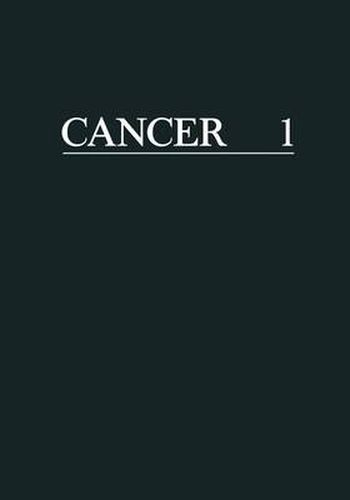Readings Newsletter
Become a Readings Member to make your shopping experience even easier.
Sign in or sign up for free!
You’re not far away from qualifying for FREE standard shipping within Australia
You’ve qualified for FREE standard shipping within Australia
The cart is loading…






This title is printed to order. This book may have been self-published. If so, we cannot guarantee the quality of the content. In the main most books will have gone through the editing process however some may not. We therefore suggest that you be aware of this before ordering this book. If in doubt check either the author or publisher’s details as we are unable to accept any returns unless they are faulty. Please contact us if you have any questions.
This series of books attempts to present, in a comprehensive manner, the field of oncology divided into three major areas; etiology, biology, and therapy. These books should serve as landmarks in the rapidly expanding experimental and clinical universe of this field. To some, they will be introductory; to others, a summary; for all, critical comments on the futuI'e of research. In l'ecognition of the difficulties inherent in attempting to pause and reflect while experimental data emerge with ever-increasing rapidity, the presentations take the form of overviews rather than reviews. Where possible, an historical perspective on observations and experimentation which led to our present understanding is presented, the state of the art in technique and approach is reviewed, and the gaps in knowledge and in technique are indicated. The aim throughout is integration-using the findings from one approach for comparison with others. The tremendous expansion of interest in oncology as a medical-biological discipline stimulated the publication of these volumes. This expansion, well warranted in terms of the impact of oncology on human morbidity, has been characterized by at least three phenomena. First, there has been an enormous increase in money and manpower devoted to the investigation and treatment of malignancy. That the research has become more and more directed or program-oriented signals the interest of those beyond the scientific community in the management of the eHort. Second, increasing numbers of students are entering the field of oncology as their major training program.
$9.00 standard shipping within Australia
FREE standard shipping within Australia for orders over $100.00
Express & International shipping calculated at checkout
This title is printed to order. This book may have been self-published. If so, we cannot guarantee the quality of the content. In the main most books will have gone through the editing process however some may not. We therefore suggest that you be aware of this before ordering this book. If in doubt check either the author or publisher’s details as we are unable to accept any returns unless they are faulty. Please contact us if you have any questions.
This series of books attempts to present, in a comprehensive manner, the field of oncology divided into three major areas; etiology, biology, and therapy. These books should serve as landmarks in the rapidly expanding experimental and clinical universe of this field. To some, they will be introductory; to others, a summary; for all, critical comments on the futuI'e of research. In l'ecognition of the difficulties inherent in attempting to pause and reflect while experimental data emerge with ever-increasing rapidity, the presentations take the form of overviews rather than reviews. Where possible, an historical perspective on observations and experimentation which led to our present understanding is presented, the state of the art in technique and approach is reviewed, and the gaps in knowledge and in technique are indicated. The aim throughout is integration-using the findings from one approach for comparison with others. The tremendous expansion of interest in oncology as a medical-biological discipline stimulated the publication of these volumes. This expansion, well warranted in terms of the impact of oncology on human morbidity, has been characterized by at least three phenomena. First, there has been an enormous increase in money and manpower devoted to the investigation and treatment of malignancy. That the research has become more and more directed or program-oriented signals the interest of those beyond the scientific community in the management of the eHort. Second, increasing numbers of students are entering the field of oncology as their major training program.